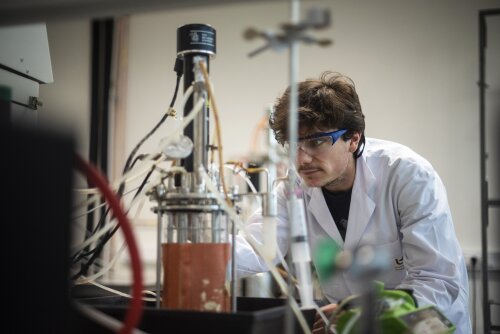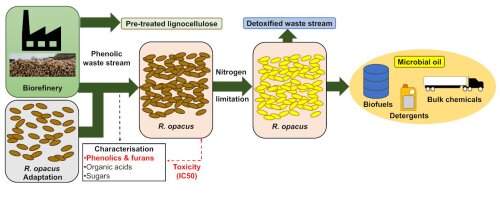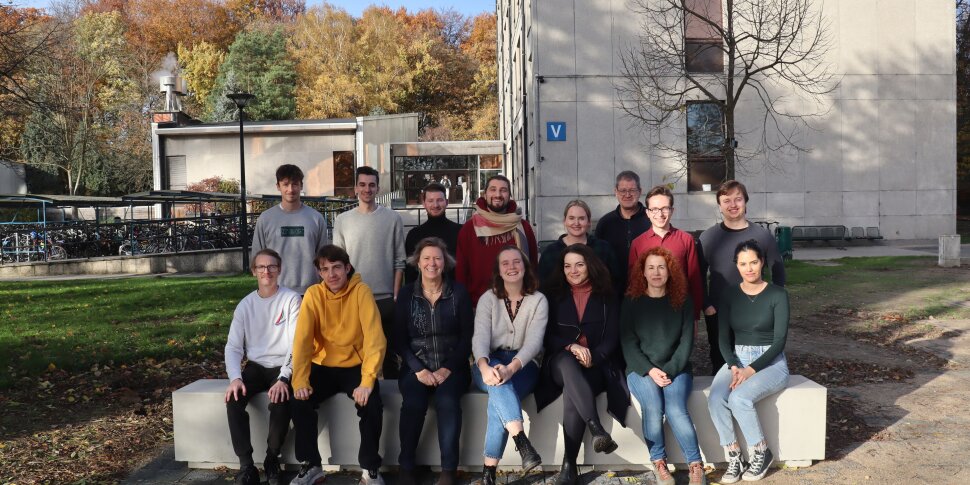Research overview
The industrial biotechnology research at BioWAVE_IB is directed to using the biorefinery approach (microorganisms, enzymes and, sometimes, chemicals) for the valorisation of industrial side-streams for the production of commodity as well as high-value chemicals, such as bioethanol, long chain dicarboxylic acids, very-long-chain fatty acids and microbial oil. Eco-efficient processes are designed and optimized based on novel and improved pre-treatment technologies of the raw material, as well as the process conditions using biochemical engineering and modelling techniques. Different fermentation strategies, such as solid state fermentation, high solids fermentations, simultaneous saccharification and fermentation as well as submerged fermentations are applied.

BOF-KP 2019 Detoxification ability of Rhodococcus sp. on the lignin-rich waste stream after steam-explosion

In the views of a circular economy, the phenolic waste streams of biorefineries should be valorized to valuable chemicals, e.g. lipids. Rhodococcus opacus PD630 is an oleaginous bacterium known for the conversion of lignin-derived compounds. However, research on the digestion of realistic phenolic waste streams is scarce. In this study, the phenolic detoxification and valorization capabilities of R. opacus were investigated using the effluent from the steam explosion of poplar biomass. R. opacus showed good resistance against most phenolic inhibitors in the effluent individually but had a low resistance against the effluent. Despite this toxicity, R. opacus was able to consume the phenolic compounds and produced a record of 61% CDW of lipids. A new capability of the bacterium, namely the extracellular oxidization of phenolic aldehydes, was discovered. Although further research is needed, R. opacus is a promising microorganism for lignin valorization in an industrial setting.
Catalytic detoxification of lignocellulosic hydrolysate
PhD project Valentin Sòti
Promotors Iris Cornet, Silvia Lenaerts
Lignocellulose-ethanol conversion is an interesting and intensely researched area of biochemical engineering. The need for an industry based on renewable energy and resources becomes more evident, as our fossil fuel reserves continue to drop. Industrial biotechnology, with bio-ethanol production, seems to be a promising direction to solve our liquid-fuel and chemical-resource problems. If the production can be based on agricultural waste or cheap renewable sources (e.g., brewery spent grain or wood, such as spruce and poplar) instead of food products, such as starch, then ethanol is a real renewable and alternative energy source for the future.
The production process consists of four main steps:
1. Pretreatment—breaking down the structure of the lignocellulose, maximizing the surface area by, mostly, physical followed by thermo-chemical methods
2. Hydrolysis—depolymerizing (hemi)cellulose to sugar monomers
3. Fermentation—metabolizing the sugars to ethanol with the help of microorganisms
4. Downstream processing —separating the chemical from the fermentation broth
During each kind of thermo-chemical pretreatment, fermentation inhibitors are formed (weak acids, furan derivatives, and phenolic components). To handle this problem, two main directions can be taken in research: finding new, more resistant fermenting microorganisms, or removing/degrading the inhibitors. This research will focus on the second path.
As previous experiments show, light molecular-weight phenolic compounds have the highest inhibiting effect. Currently, in the field of phenolic inhibitor removal from pretreated biomass most research addresses enzymatic biodegradation, while only a few publications can be found about removal and degradation by a chemical catalyst.
Adsorption can be an efficient inhibitor removing method, but the problem is that adsorbent regeneration is needed. Adsorption is a part of the process in any fixed bed degradation, with two main process steps: chemical adsorption and catalysis. Chemical adsorption has been used to remove inhibitors in lignocellulose fermentation, with zeolites, TiO2 (specific phenol), resin, polymeric adsorbent and granulated charcoal. Degradation with a photocatalytic method by TiO2 semiconductor catalyst seems promising.
Immobilization of phenol degrading enzymes is reported in several articles, for example laccase on activated glass or on PVA, although no reports were found about utilization in phenolic removal from hydrolysate.
There are still some major problems that prevent industrial application of removal techniques for phenolic compounds from lignocellulose hydrolysate. For example, selective removal of the inhibiting compounds is necessary for cost reduction; regular regeneration in case of an adsorption column has to be avoided, reuse of the catalyst by immobilization is recommended, etc.
Shared article!
Here you can find a personalized URL providing 50 days' free access to my second latest article. Anyone clicking on this link before March 24, 2018 will be taken directly to the final version of this article on ScienceDirect. Simply click and read.
https://authors.elsevier.com/a/1WZGwcF8RyJLw
Novel fermentative production of long-chain dicarboxylic acids from
PhD project Jordy Bauwelinck
Promotors: Iris Cornet, Serge Tavernier
Today's chemical industry knows a great demand for new high performance, green and cost effective building blocks. One type of these new building blocks are long chain dicarboxylic acids. These are already commonly used in high performant coatings, as lubricant and as a food additive. Chemical synthesis of these compounds is difficult and generates lots of unwanted side products. To counter this a biochemical production method has already been developed using a yeast which converts fatty acids to these dicarboxylic acids. This production process is fine except for the fact that high valuable, expensive and food competitive compounds are used as raw material. This project will tackle these problems by developing a new 3 step fermentation process. The basic concept is to grow yeast cells using a sugar-like waste stream (e.g. molasses) as feed but in a nitrogen limited environment. This will cause a reduced growth and lipid accumulation inside the yeast cell. Afterwards a starvation period is initiated and these produced lipids will be converted to dicarboxylic acids which are secreted into the medium.
This production process will cause a serious cost reduction as it uses sugar waste streams as raw material and also simplify the production of the dicarboxylic acids. There will be no longer need for large vegetable oil producing crops, no need for fossil oil or a yeast oil production step, which results in less production steps and a greener, more cost-effective process.
FTIR as an easy and fast analytical approach to follow up microbial growth during fungal pretreatment of poplar wood with Phanerochaete chrysosporium
PhD project Nikolett Wittner
Promotors Iris Cornet, Serge Tavernier
Shared article!
Here you can find a personalized URL providing 50 days' free access to my second latest article. Anyone clicking on this link before March 24, 2018 will be taken directly to the final version of this article on ScienceDirect. Simply click and read.
https://authors.elsevier.com/a/1WV4fc8NxYv2E
